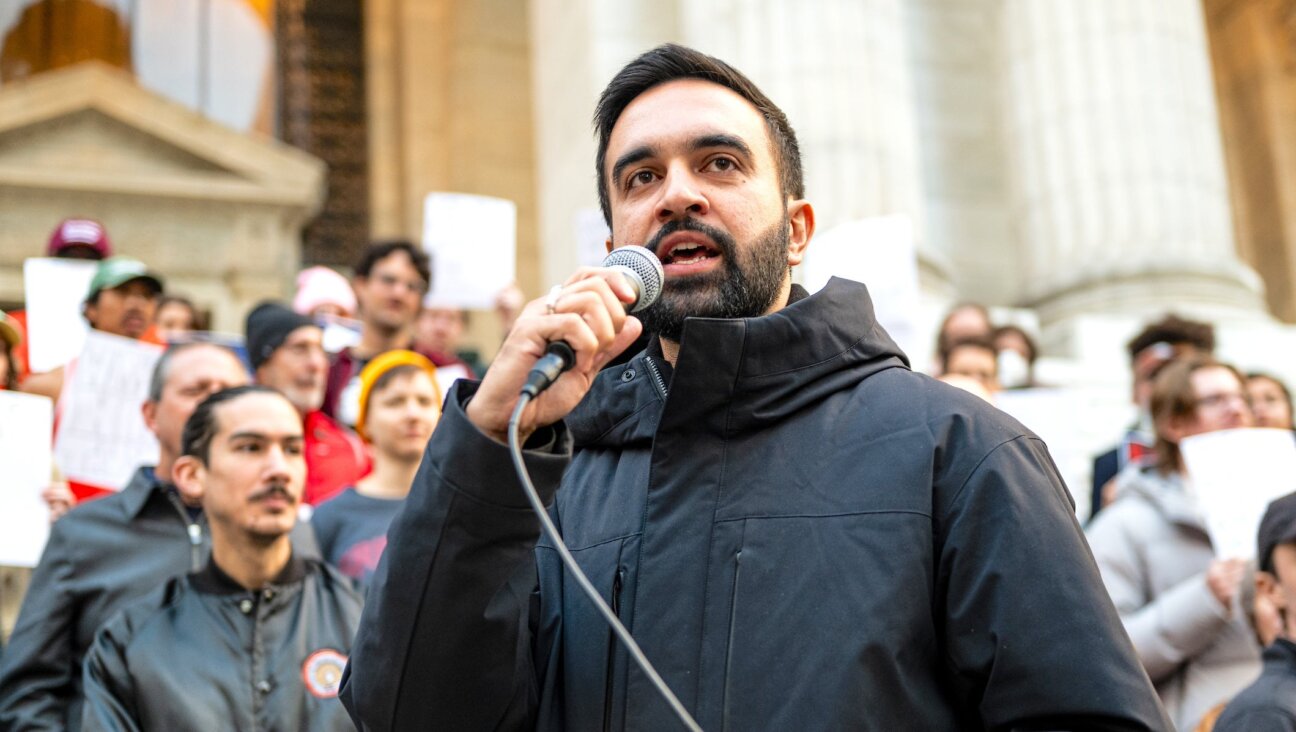Workmen’s Circle Builds Chicago Chapter With Progressive Message — And No Talk About Israel

Image by Courtesy of the Workmen’s Circle
It was at a Purim party last year that Rivka Yeker, a student at DePaul University, met a 20-something woman like herself, who taught at a unique, recently established school for young Jewish children.
The Workmen’s Circle’s Sunday school, Yeker learned, stressed Yiddish culture and social justice, and focused on Israel hardly at all.
Yeker was immediately taken with the school’s curriculum, and with the ideas of the Workmen’s Circle itself, which sponsored the program. During her freshman year, Yeker, 20, whose parents are Soviet Jews, tried becoming involved in Hillel and Chabad, but found she didn’t really share any interests with those she met there.
“Judaism to them is white,” she said, referring to the Hillel and Chabad House students. “I don’t know how to say this, I don’t want to offend anyone — but it felt like there was no room for progressive thinking or anyone who didn’t fit into the white, Ashkenazi, hetero, cis mold. They will technically accept you, but it’s still weird. You’re always on the outskirts.”
Yeker and her friends had been looking for a way to combine their social consciousness with their Jewish heritage. But until their Purim encounter, none had thought to pursue this via a group that many Jews don’t even know still exists. Now Yeker and her friends are involved with building the Chicago chapter of the Workmen’s Circle.
Founded in 1900 in New York, the Workmen’s Circle functioned as a combination mutual aid society and agency for workers rights. Its members were largely Jews of Eastern European origin or descent who leaned left politically. (Over time, they evolved to New Deal Democrat from socialist.) They were anti-assimilation and anti-Zionist, and, between political marches, they cultivated a rich Yiddish culture; many of the Workmen’s Circle’s members were involved with this very newspaper.
The movement started to fade by the 1950s as Jews assimilated — and the Holocaust ended the possibility that many more Eastern European immigrants would follow to take their place. In recent years, though, the Workmen’s Circle has been experiencing a resurgence. It’s attracting many younger Jews who are either unwilling or unable to pay synagogue dues, or who, like Yeker and her friends, don’t feel much of a connection to more established groups. Most, they found, are connected in some way to the Jewish federations, whose politics too far to the right for their comfort.
According to a 2013 study by the Pew Research Center, less than one-third of American Jews belong to a synagogue. Young Jews, in particular, are averse to joining groups and institutions. And the Workmen’s Circle isn’t immune to this; its membership has declined to 8,000 today from 10,000 in 2013. But during this same period its mailing list has steadily grown, and today it stands at 25,000, according to Ann Toback, the group’s executive director.
“I think that one of the weaknesses of the American Jewish landscape has been that it hasn’t tied together all the many different parts of our history and traditions,” Toback said. “There’s been a conscious effort [among Ashkenazi Jews] not to embrace their Eastern European heritage. The unimaginable tragedy of the Holocaust has pushed many people to look in only one direction for Jewish tradition. By denying 1,000 years of Eastern European heritage, we created a generation who weren’t fully formed in a way.”
The Workmen’s Circle, Toback said, sees Ashkenazi Jewish identity as a holistic tapestry: “culture, social justice, Yiddishkeit, learning — it all goes into Jewish identity.”
Jill Morowitz, one of the founding parents of the Sunday school, was most attracted to the Workmen’s Circle’s concentration on art, culture and history, and to its belief that social justice was not just about charity, but also about working toward permanent change in the community.
Morowitz grew up attending a Conservative synagogue in West Rogers Park, on Chicago’s North Side. She went to Hebrew school twice a week. There she learned a bit about the holidays and the Torah, but what she really remembers is how her teachers spent most of their time trying to keep the students from fighting and from throwing food at each other. When she grew up and had children of her own, twin boys now in third grade, she and her husband joined a synagogue and enrolled the children in Hebrew school, just as their parents had done. “If you wanted to raise your kids Jewishly,” she explained, “that was how you did it.”
But something was missing. The building was nice, the people were kind, but she and her husband didn’t feel a real connection to the synagogue. Other synagogues didn’t feel right, either.
Morowitz and a group of friends were preparing to start their own religious school so that at least their children would have a Jewish education. But then, through a relative, she learned about the Workmen’s Circle; or, rather, she learned that a group she thought long dead still existed.
Even more important, Morowitz learned that Toback, then seeking to re-establish the Workmen’s Circle’s presence in Chicago, was launching the sort of school she’d been looking for — one in which spirituality is important but where members are not required to follow one specific doctrine.
As Morowitz put it, “No one has to feel bad about not believing in something.”
Now two years in, there are a dozen students in the Chicago group’s Sunday school, ranging from kindergarten through third grade, with another wave of younger siblings waiting in the wings. Morowitz said her children enjoy their lessons, especially Yiddish, and have found meaning in them.
A few people from the Chicago Coalition for the Homeless came to visit the class one day and talked about their own personal experiences of being homeless. This was eye-opening for the students, who’d mostly associated homelessness with the people they saw sleeping in the street, not with people who slept in shelters or who couch-surfed because they had no place to go. They began discussing possible solutions; Morowitz said her children are still talking about it.
“The connection between social justice and Jewish values shouldn’t ever feel like a compromise,” said Isaac Brosilow, 25, who has become the group’s political organizer. “But so often in the way I was raised, it has felt like that. I wanted to be proud to be Jewish, and I was disgusted that people like Stephen Bannon were getting standing ovations at [the American Israel Public Affairs Committee].”
Describing the Trump administration’s aims and policies as a threat “to all of us,” Brosilow said: “If that’s what you’re going to justify to save the Jewish people, I don’t care about you. History has shown us that we can’t settle up next to power.”
In early May, Brosilow began leading a study group of socialist and Jewish texts. They started with “The Jewish Question” by Karl Marx. Many regard the essay as anti-Semitic in its negative stereotypes of Jews and Judaism, even as it calls for the emancipation of European Jewry to, supposedly, change these characteristics. This opened up a discussion about what it means to be a Jew and a leftist.
In another activity, Brosilow and Yeker have recruited a Yiddish-speaking friend who is now giving members informal lessons in the old language. The friend, Leah Whiteman, believes her students are drawn to Yiddish because it’s a way of claiming a Jewish identity that’s tied more to culture than to faith or to Israel.
On May Day, Whiteman, Brosilow, Yeker and a few others joined in the citywide march and rally in Union Park, where they met some older Workmen’s Circle members. “It was amazing and beautiful to watch young Jews and older Jews that have similar beliefs meet and become a part of each other’s communities,” Yeker said.
The two Workmen’s Circle groups, the parents and the activists, have yet to gather together formally. But Morowitz and Brosilow are looking forward to uniting them into a strong and robust chapter, along with the older people and anyone else who feels he or she has no place in the Jewish world. For many, that means rejecting the Israel-centric focus of most other groups, both left and right, in favor of struggling for social justice in the United States.
When Brosilow began to study the history of the Workmen’s Circle, he learned that its members in the early 20th century had embraced what they called doikayt, or “here-ness,” as opposed to Zionism, or “there-ness.”
“I always felt that,” Brosilow said, referring to this priority. “But I’m glad to know there’s been a word for it since 1905.”
Aimee Levitt reports regularly on Chicagoland for the Forward. Contact her at [email protected]. Follow her on Twitter, @aimeelevitt






















